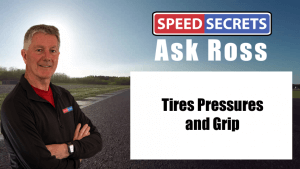 Q: “How do I try to manage my tires’ heat so that they don’t get oily and slick as the day gets hot as I’m driving? I’ve noticed I can get efficient traction my first two laps if it is hot out, but after that the tires seem to want to slide a bit more.”
Q: “How do I try to manage my tires’ heat so that they don’t get oily and slick as the day gets hot as I’m driving? I’ve noticed I can get efficient traction my first two laps if it is hot out, but after that the tires seem to want to slide a bit more.”
A: As the track temperature goes up over the course of a day, tires typically lose grip. That’s why you’ll often turn a faster lap in the morning than in the afternoon, even though your driving has improved. It’s something you have to accept, and your goal should be to drive to the limits of your tires, even though those limits are changing. You may be able to adjust tire pressures to help, but only so much. Remember, it’s your hot tire pressures that matter, not what they are when cold. Let’s say you set them to 30psi in the morning, go out and drive, and they go up to 36 psi on track. If you leave them there for the rest of the day, in the heat of the afternoon they may be up to 38 or 40 psi. So that means you might want to try reducing your starting pressures as the day heats up. For sure, you should keep track of this – measure your tire pressures as soon as possible when you come off the track (if you do a slow cool down lap, slowly drive around the paddock, casually get out and talk to friends for 5 minutes… then your pressure are kinda worthless; you need to get the pressures as close to the way they were on track). If you check pressures after every session, eventually you learn what pressure they’re at when they feel best to you. I strongly recommend writing pressures and what you felt in a notebook or on your smartphone. It’ll help you learn more in less time. You may find that you can have more consistent performance simply by paying attention to hot tire pressures.
